Drive-by botany: Frost aster and evening primrose
Profiles of common Michigan roadside flora in mid-September 2021.

Authors’ note: Drive-by Botany is a continuing series that highlights flowering plants commonly seen from the road. As a service to new readers, we include the introduction with each article. If you're already familiar with the premise, feel free to skip down to the good stuff.
Has a patch of flowers ever caught your eye as you travelled down the road? It certainly happens to us all the time! As gardeners and naturalists, we're always interested increasing functional diversity in our gardens and landscapes, so we thought it would be fun to consider some of the roadside plants that we see every day. Each article in this series will feature two plant species that are currently blooming and frequently observed from the road. Our goal is to answer two simple questions:
- What are they?
- Would they make good garden plants?
As part of the process, we'll include some biological tidbits and a few useful characteristics for identification. Please note that some of the plants we feature are exotic invasive species; we'll be sure to include recommendations from land management professionals on how to manage them in your landscape.
September 2021 – week 38, growing degree days (GDD) 5,654 base 32, East Lansing, Michigan
Frost aster (Symphyotrichum pilosum)
Common names: Hairy aster
Late summer/early fall is the time when asters shine and provide some late season color along the side of the road. With its dainty white flowers, frost aster is a common sight, sometimes even growing in the road through cracks in the pavement. Frost aster is a member of the aster family (Asteraceae.) This series has profiled two other members of this large family: spotted knapweed and chicory. You can learn more about the floral characteristics that are used to identify and classify members of the Asteraceae family in the chicory profile.
Symphyotrichum pilosum gets one of its common names, frost aster, from its cold tolerance. The dainty white flowers may persist into early November. It is an herbaceous perennial with erect stems that arch, spread and create a shrubby appearance. Mature height ranges from 2 to 4 feet.
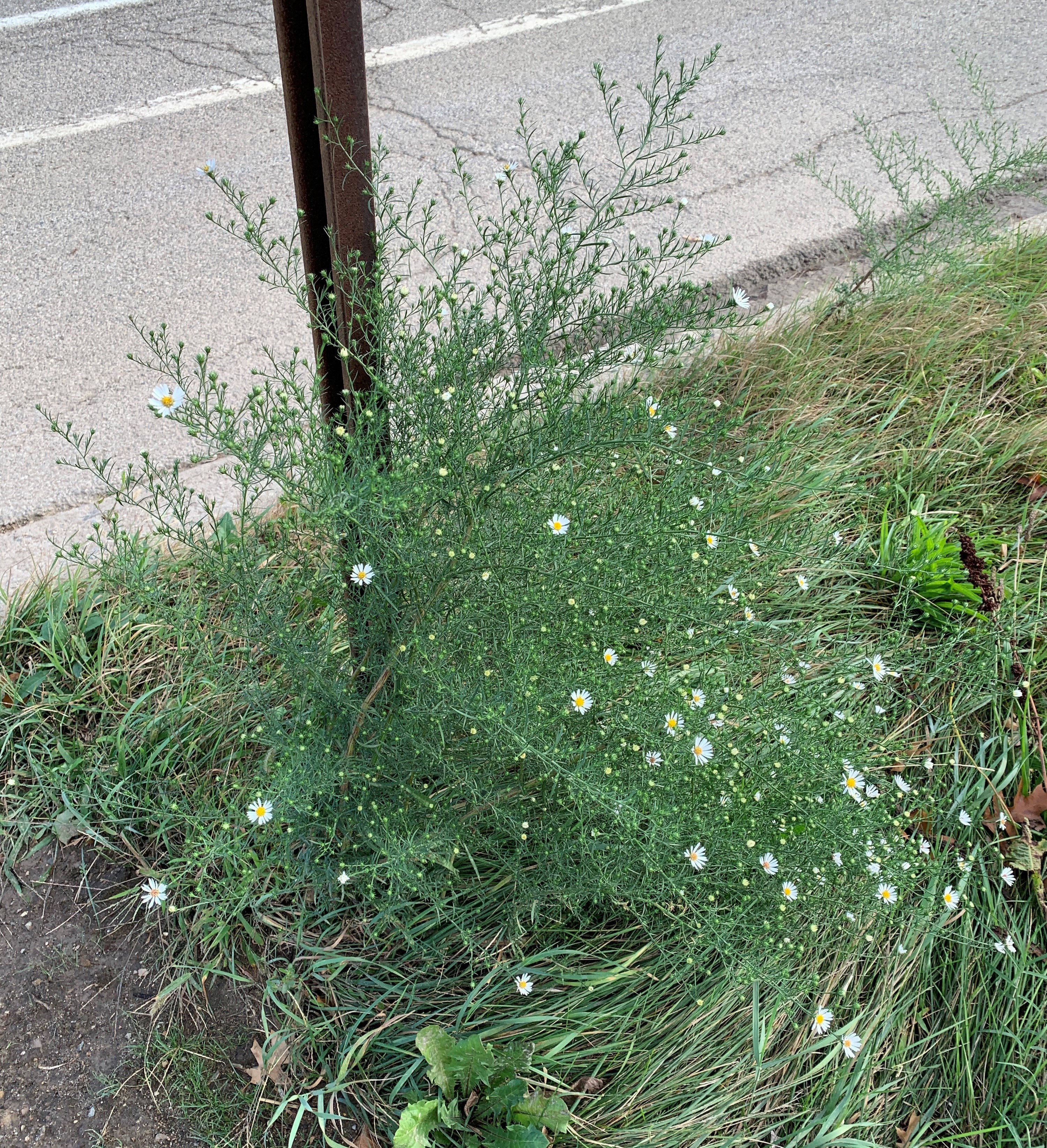
Description
Flowers: Frost aster flowers have white ray flowers that surround the central yellow disc flowers that can turn reddish purple to reddish brown as they senesce. Individual flowers are usually about ½” to ¾” across. Another identifying feature is the presence of pointy bracts around the inflorescence.
Quick definition: Senesce means to deteriorate with age (living organisms).
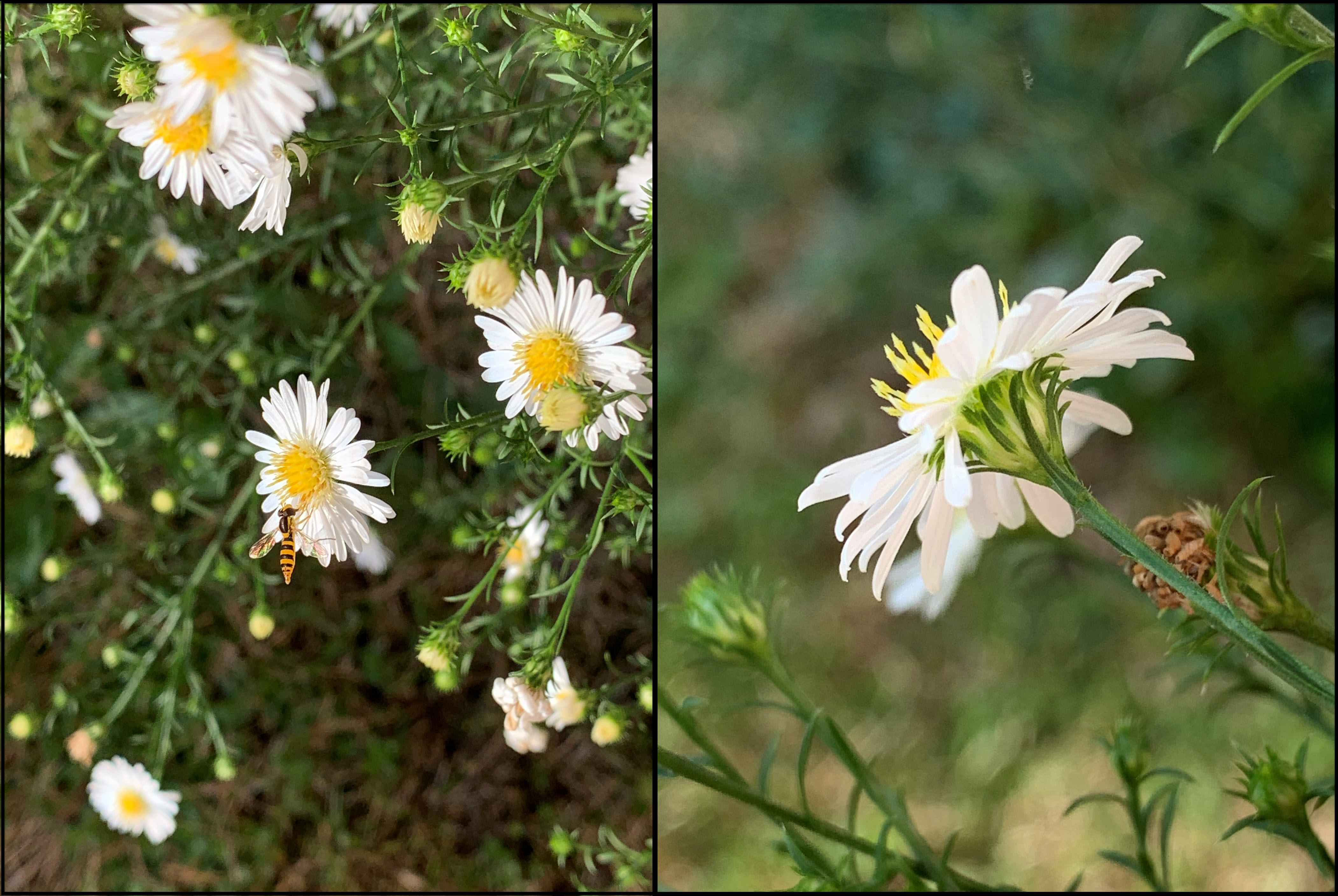
Leaves: Leaves are alternately arranged along the stems and progressively become smaller and more linear near the top of the plant. Secondary leaves may develop from the axils of the primary leaves (where they arise from the stem).
There are two varieties of frost aster found in Michigan, and hairiness of the leaves depends on the variety. First is Symphyotrichum pilosum var. pilosum, which has small spreading hairs on leaves and is common inland in the southern Lower Peninsula and in some disturbed areas of the Northern Peninsula. The second variety is Symphyotrichum pilosum var. pringlei, which has mostly hairless leaves and is found near the shores of the Great Lakes.
After plants die down at the end of the season, a semi-evergreen rosette of basal leaves develops and can persist from fall into spring. Leaves of the basal rosette may be hairy or hairless, are about 3 inches long and 1 inch across. They are usually elliptic, but sometimes taper more towards where the leaf originates from the rosette.
Stems: Similar to the leaves, the hairiness of the stems depends on the variety. Symphyotrichum pilosum var. pilosum tends to have stems covered in small white hairs, while Symphyotrichum pilosum var. pringlei has mostly hairless stems.
Seeds/fruit: Seeds are small (1 to 1.5 millimeters) with white tufts of hair attached that allow them to be carried away by the wind. They mature into the late fall.
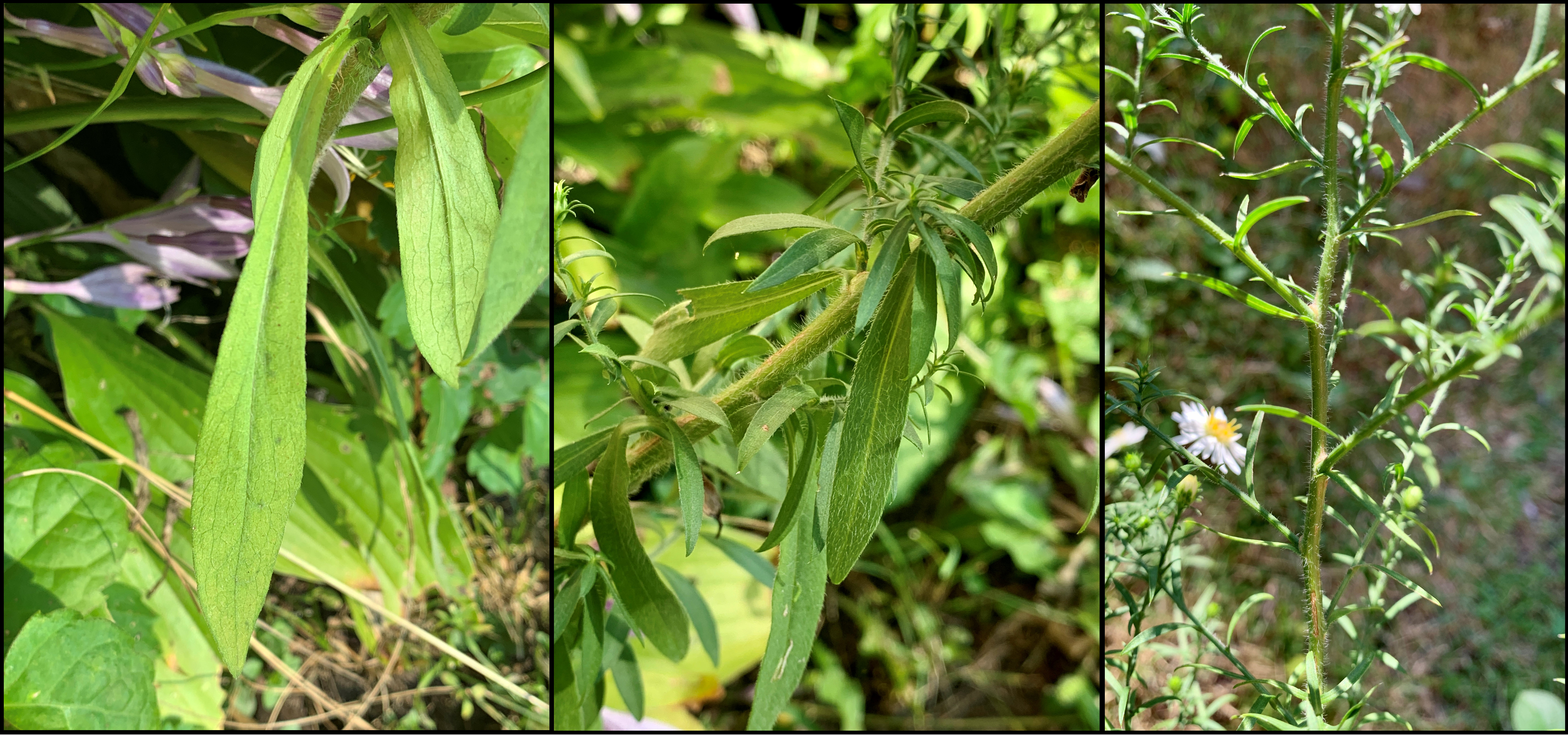
Distribution: Frost aster has been documented in 56 Michigan counties. Symphyotrichum pilosum var. pilosum grows in open fields, prairies, near shores and in disturbed sites. Symphyotrichum pilosum var. pringlei grows in lime rich soils, interdunal flats and on sandy, gravelly shores. It is not commonly found inland like Symphyotrichum pilosum var. pilosum is.
Blooming period: Frost aster usually begins blooming in August and can persist into November.
Native status: This species is native to central and eastern North America.
Garden uses: Frost aster forms a branching root system and can spread aggressively via seed and rhizome. Therefore, it can be considered weedy. It does, however, offer delicate, late season blooms and a nectar/pollen source for insects. Many insects such as bees, flies, butterflies, beetles, and moths visit the flowerheads at the end of summer and into early fall. It fills a special niche with these late season blooms. If there is space for it to naturalize, or if special care is taken to remove seedlings, it could be an intentional garden addition. Pinching the stems back in late spring or early summer can also help create shorter plants that need less support or staking.
Common look-alikes: There are certainly many other small, white-flowered asters out there. Heath aster (Symphyotrichum ericoides) is often mistaken for frost aster and vice versa, but panicled aster (Symphyotrichum lanceolatum) and calico aster (Symphyotrichum lateriflorum) have a similar looking flowers.
Common evening primrose (Oenothera biennis, Oenothera spp.)
Common names: sundrop, fever-plant, weedy evening primrose, evening star, King’s cure all
Common evening primrose is member of the Onagraceae, a comparatively small group of plants known collectively as the evening primrose family. The flowers of common evening primrose open in the evening and are usually closed by the middle of the next day, suggesting that their primarily pollinators are nocturnal or, at the very least, crepuscular. Despite the common name, plants in the Onagraceae are not true primroses. True primroses belong to an entirely different botanical family (Primulaceae).
Quick definition: In zoology, crepuscular refers to animals that are active in the twilight hours.
Description
Flowers: Evening primrose flowers are bright yellow with four bi-lobed petals and are arranged in clusters at the end of tall spikes. The flowers are approximately 1-2 inches in diameter and typically bloom for a day or two before senescing.
Leaves: Leaves are lance-shaped and usually range from 3-7 inches long and 0.75 to 2 inches wide. As a biennial species, O. biennis exhibits the typical growth pattern by spending its first year as a basal rosette and then bolting in its second year. Leaves on the flowering stems have margins that are either entire or are "shallowly-toothed" and usually arranged alternately in a spiral pattern up the stem.
Quick definition: When the margins of a leaf are said to be entire, it means they are smooth and without teeth or indentations.
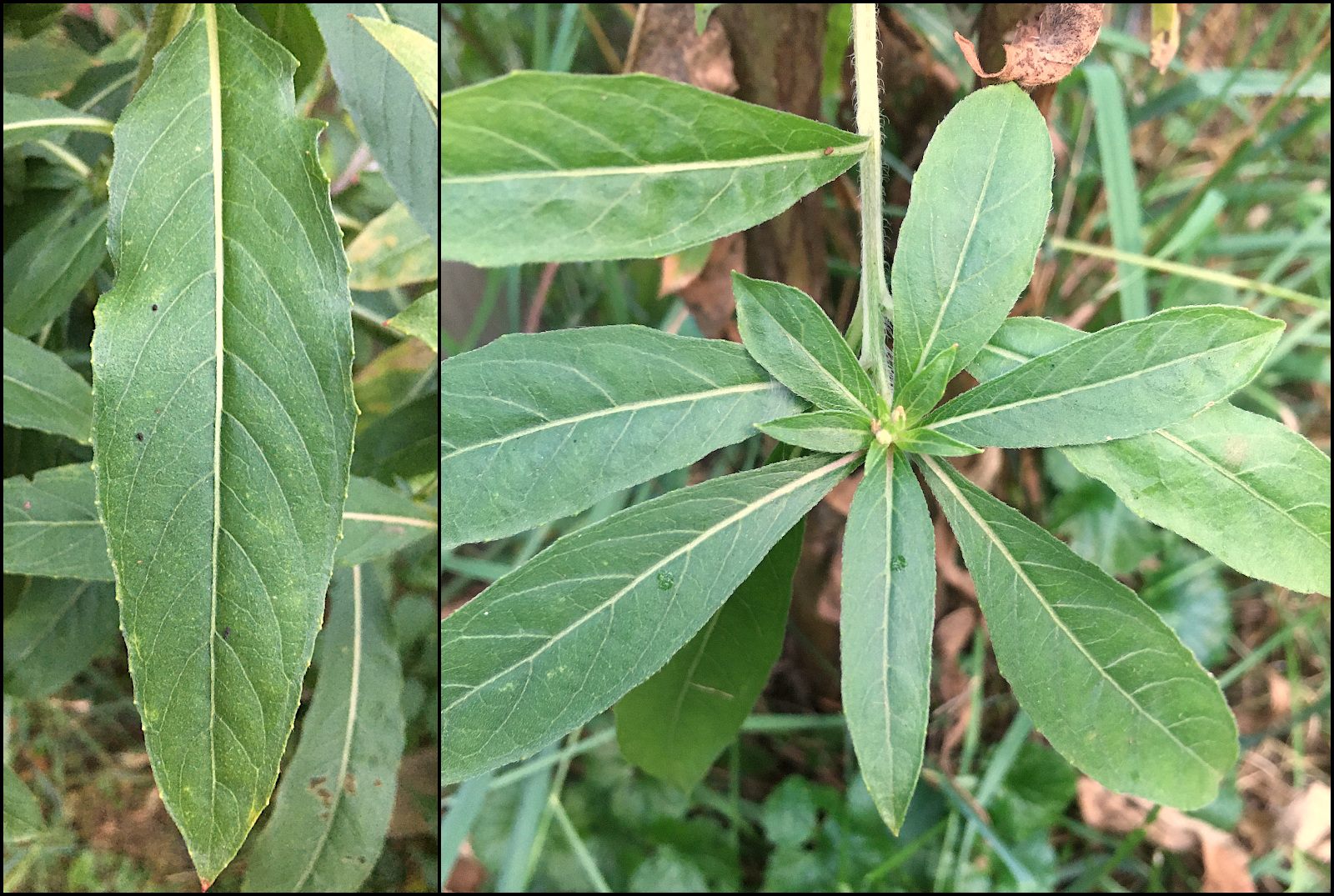
Stems: The flowering stems are green, although the lowest parts turn a reddish-brown as they become woody over the course of the season. Although some texts say that this plant grows to a little over 5 feet in height, the authors frequently encounter specimens over 6 feet tall.
Seeds/fruit: Evening primrose produces fruit as narrow green capsules, roughly 1 inch long, that turn brown and split open when ripe.
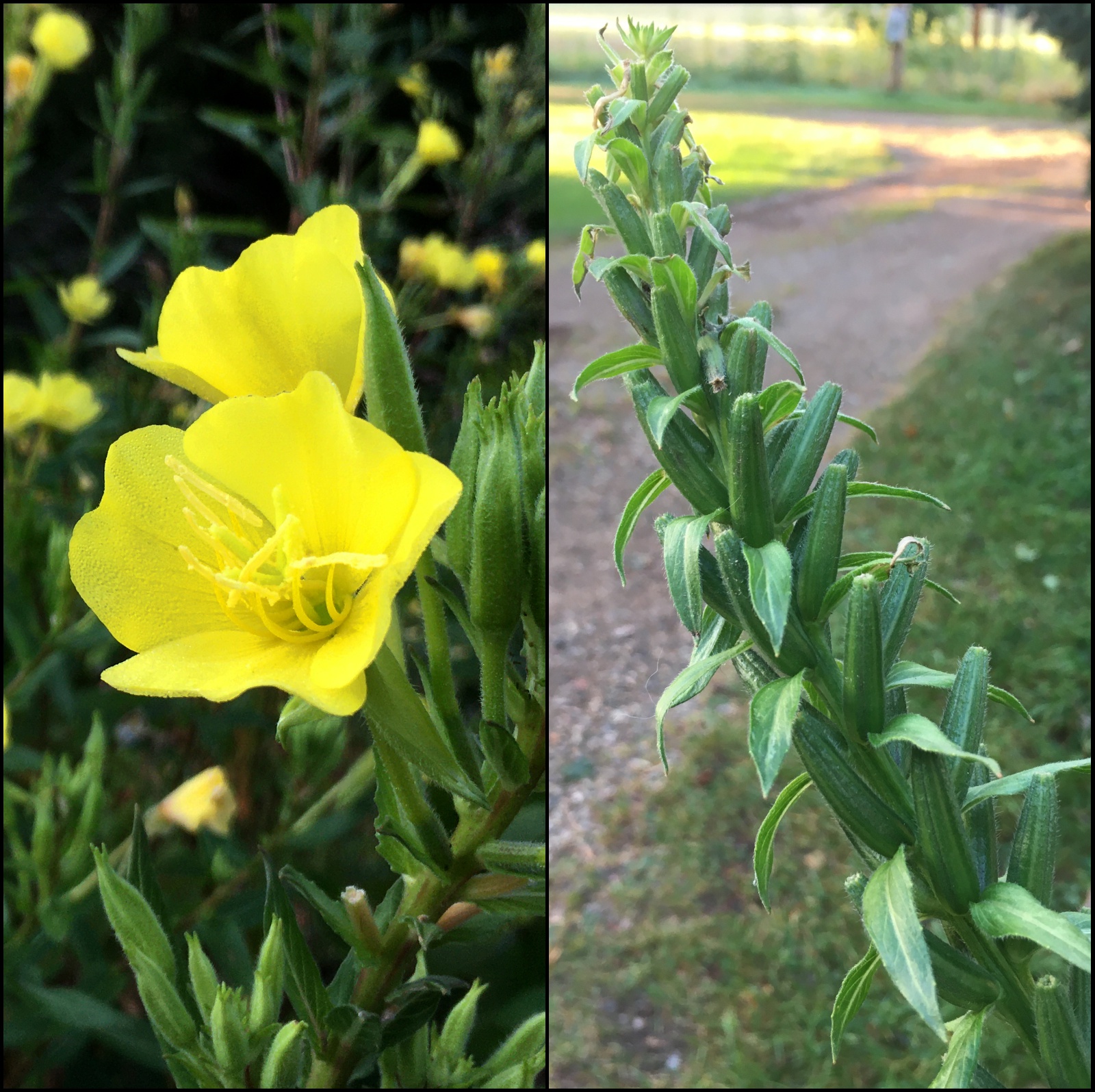
Distribution: Oenothera biennis has been officially documented in 59 Michigan counties, including every county in the upper peninsula. It can be found in sunny habitats with soil types that range from heavy and moist to dry and coarse. Because the seeds germinate readily, it is found frequently in areas that experience regular ecological disturbance (e.g., gardens, roadsides).
Blooming period: Evening primrose typically starts blooming around mid-July and continues into October.
Native status: This species is native to the lower 48 states and Canada.
Garden uses: Evening primrose is a plant with a high degree of utility. Historically, Native American tribes are documented as using it for food as well as medicinal purposes. Elias and Dykeman (2009) provide recommendations on how to prepare leaves and roots for consumption. The oil extracted from seeds of O. biennis contain two essential fatty acids and is sold commercially as a dietary supplement.
Common evening primrose is best suited for gardeners that are going for a more natural look to their gardens. While the leaves and flowers are attractive, its growth habit and architecture give the plant what many would describe as a "weedy" appearance. Like many natives, O. biennis may grow excessively tall and flop over in nutrient rich soils. This species produces a large amount of seeds that germinate readily in variety of habitats and can be a little aggressive in garden settings. Annual removal of seedlings may be required to preserve the status quo.
Jeremy's gardening tip: Many native species respond favorably to a hard pruning in mid- to late-June. Not only does this limit the final height and reduce the chance of it flopping over, it may also stimulate the plant to produce a higher number of flowering stems.
Common look-alikes: There are several closely related species (O. glazioviana, O. oakesiana, O. parviflora, and O. villosa) that experts have a difficult time differentiating from each other (Voss 2001). Moreover, each of the aforementioned species uses some variation of “evening primrose” in their common name – a confusing situation, to be sure. When it doubt, it’s perfectly OK to call it evening primrose or Oenothera.
Want more Drive-by Botany?
Check out some of our recent roadside adventures!
Questions? Feel free to contact Jeremy Jubenville or Isabel Branstrom with the MSU Extension landscape team.
Resources
- Michigan Flora (2001) – E. Voss
- USDA NRCS Plant Materials Program
- Edible Wild Plants (2009) – Elias & Dykeman



 Print
Print Email
Email





